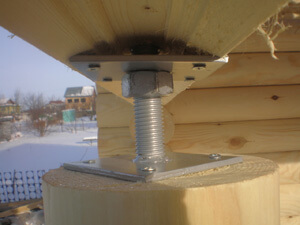A house made of wood, even dried wood, goes through a settling stage due to the characteristics of the construction material as well as the weight of the structure. This is more typical for wooden structures made of logs and sawn timber that are installed horizontally. Settlement occurs due to soft layers of wood shrinking. As a tree grows, annual growth rings appear. The thickness and softness of these rings directly depends on the season and the humidity of that year. In winter, the moisture content of wood is greater, but the tree does not grow, while the thickest part of the ring is formed in summer over a rather short period of time. This part of the annual ring is more porous and softer than the one that was formed in the off season. It is this soft part of the ring that contracts with time.
If you take a single log or log row of your log house, wooden house, bathhouse or cottage, shrinkage is unnoticeable, but when you take an entire log wall, which can comprise several dozens of log rows, shrinkage amounts to up to 6%. For logs walls with a height of 300cm, shrinkage is 18cm.
It is a known fact that shrinkage does not occur along the layers and the length of tree trunks, therefore, supporting posts that are used in the structure of a house do not shrink in relation to the part of the wall, from the base to the log row, on whose level seats the offset structure of the house. House jacks, or shrinkage compensators, are used to make sure that the log rows of a wooden house do not get stuck on the support posts and columns and the house itself does not become misaligned.
External look of a house jack
It is a essentially a screw that is fixed onto a base plate from one side and into the support nut, which rests on the pole, from the other. This design serves as a guideway, which allows a support post or column to perform its structural function while a house settles, and makes it possible to reduce a gap between the edge of the support column and the bottom surface of the supported part of the structure by turning an adjustment nut during the settling process. This process of tightening the adjustment nut lasts until the house settles completely; in the end, the upper part of the support post will abut up against the supported surface.

It is characteristic of wooden frame houses to have a frame that does not settle due to the fact that the load-bearing pillars of the frame structure, which are made of wooden posts and timber, are installed vertically.
The North House company uses high-quality construction materials with natural moisture content. Our careful approach to choosing materials and preparing them for construction in advance allows us to make accurate preliminary calculations for the length of a house jack that is being installed to compensate shrinkage. As a result, when a house, log building, wooden cottage or bathhouse settles, you will get perfectly fitted support posts and columns.